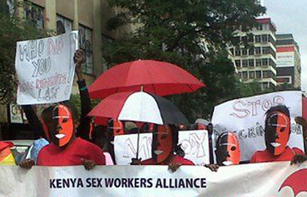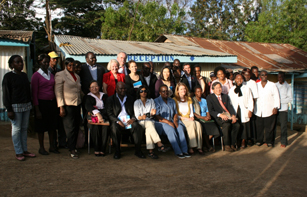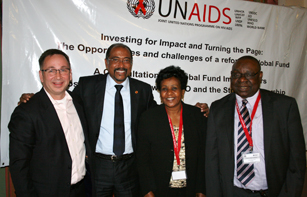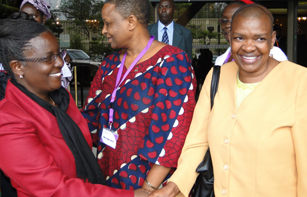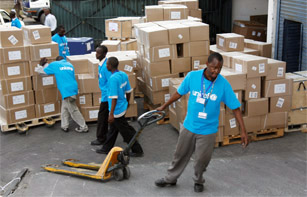
Press conference to announce the swearing in of the HIV Equity Tribunal. Panelists from left to right: Prof Mary Getui, Chair of Kenya's National AIDS Control Council (NACC) board; Ambrose Rachier, Chair of the HIV Equity Tribunal in Kenya; Hon Esther Murigi , Minister of Special Programmes in Kenya; Hon Mohammed, Former Assistant Minister, Special Programmes.
Credit: UNAIDS
At the June 2011 High Level Meeting on AIDS, world leaders pledged to eliminate stigma and discrimination against people living with HIV by promoting laws and policies that advance human rights and fundamental freedoms. The recent creation of an HIV Equity Tribunal in Kenya—the first of its kind globally—represents a bold step towards achieving this goal.
An estimated 1.6 million people are living with HIV in Kenya. The seven-member Tribunal will provide access to justice for Kenyans who face stigma, discrimination or criminalization based on their HIV status. It will also seek to advance the rights of women and girls, who are disproportionately affected by the HIV epidemic in Kenya.
The Joint UN Team on HIV and AIDS in Kenya, through UNDP and UNAIDS, will support the Tribunal by building its capacity to operate effectively, providing technical support, and creating demand within communities through advocacy.
UNAIDS spoke with Ambrose Rachier, Chair of the Tribunal, about the opportunities and challenges that lie ahead.
What is the mandate of the Tribunal? How will the Tribunal carry out its mandate?
The mandate of the Tribunal is outlined in the 2006 HIV/ AIDS Prevention and Control Act.* The Tribunal has jurisdiction to hear and determine complaints arising out of any breach of the Act and any matter or appeal as may be made pursuant to the provisions of the Act. The Tribunal can also perform functions related to the Act, excluding criminal jurisdiction.
Court proceedings can take years in Kenya. The Tribunal can quicken access to justice for people living with HIV. What are the other expectations of the Tribunal?
The Tribunal has the power of a court and can receive evidence, hear witness accounts, conduct full hearings and pass judgments on the above matters. With this in mind, it is expected that the Tribunal will focus on the protection of human rights of people living with HIV. It therefore encourages those infected with and affected by HIV that have been violated in any manner that is a breach of the HIV/AIDS Prevention and Control Act of 2006 to come forward and air their grievances.
How do you plan to discharge your mandate?
The Tribunal has established a registry that receives complaints and grievances in writing. The different complaints are reviewed and assigned as appropriate. The Tribunal also assists members of the public who may be illiterate to record their complaints.
What actions have been undertaken by the Tribunal so far?
Since the swearing in of the members, the Tribunal has received various matters, reviewed them and categorized them based on the general complaints as follows:
- A majority of the complaints received relate to workplace issues that discriminate and stigmatize employees on the basis of their real and/or perceived HIV status. These range from termination of employment, demotion and irregular transfer of employees based on their HIV-positive status.
- The second category of cases relate to denial of access and difficulty in access to HIV treatment, mainly arising from claims of persons being transferred to remote areas of the county where antiretrovirals, medications for opportunistic infection and HIV prevention services and commodities cannot be readily accessed.
- The last category involves cases that arise from family relations and primarily affect women who, on the grounds of their HIV-positive status, may have suffered domestic violence, abandonment or the disinheritance of property.
What are the immediate plans for the Tribunal?
The immediate plan is to build the capacity of Tribunal members to enable them hear and resolve matters, as only three of the seven members are officers of the court. The Tribunal first sat and dealt with two complex cases on 31 January. A campaign to publicize the Tribunal and the access to social justice is planned so as to enlighten the public and create awareness of the services of the Tribunal.
How do you envision the Tribunal will contribute to the national response to HIV?
The Tribunal will help discourage discriminatory practices, encourage inclusivity and uphold involvement of people living with HIV. It will also increase the space for social dialogue on HIV-related stigma, increase knowledge and awareness, and reduce stigma. This will help increase access to HIV prevention services and practices, increase uptake of services, and create demand for HIV prevention, treatment, care and support services.
What opportunities lie within the Tribunal to address stigma and discrimination—a persistent bottleneck to achieving universal access?
The Tribunal will be an excellent vehicle for reaching out to other institutions that knowingly or unknowingly exacerbate stigma and discrimination, including the insurance sector, employers and even institutions of learning. The Tribunal can complement and provide awareness around ethical and legal issues surrounding HIV and on how to treat those in your charge that could be affected.
What do you expect are the anticipated challenges for the Tribunal?
The Tribunal is currently experiencing a lack of goodwill and resistance by some parties with specific interests. This has hampered our work. The bureaucracy is also a hindrance affecting the optimal performance of the Tribunal, and it delays the legal redress that is needed. Those affected may continue to suffer as they await justice and may lose faith in the Tribunal. It is known that Justice Delayed is Justice Denied. We do not want to set such precedence, but the bureaucracy is a big limiting factor.
The Tribunal will help discourage discriminatory practices, encourage inclusivity and uphold involvement of people living with HIV
Ambrose Rachier, Chair of the HIV Equity Tribunal in Kenya
The other challenge will be to operationalize the Tribunal and discharge our duties effectively in the coming devolved structure of governance. Currently the intention is for the Tribunal members to hold rotational sittings by province. However with the devolved structure, the seat of governance will be at the proposed 47 counties, and this may overwhelm our seven-member Tribunal to adequately discharge justice.
Despite these challenges, I am optimistic and proud to have been part of this unique Tribunal that is the first of its kind in the world. I hope that other countries will emulate our experiences and learn from our successes and challenges.
Other countries may be interested in how this idea came about, and how long it took to bring to fruition.
In 1999, HIV was declared a national disaster. This led to the establishment of the National AIDS Control Council. A taskforce on HIV and the law was also instituted.
The mandate of the taskforce was to provide legal guidance on what laws are necessary to facilitate HIV prevention, treatment and care. I was the chair of that taskforce. In 2000, we began our work and completed a report in July 2002. At the time, we identified three key issues that could be addressed: i) Stigma and discrimination were factors that escalated the spread to HIV ii) There was a need to address issues of access to HIV prevention, treatment and care services iii) Access to justice for people living with and/or affected by HIV as a means to improve the national response. After the submission of the report, the drafting of the HIV/AIDS Prevention and Control Act began and was passed in 2006. This Tribunal was enshrined in the said Act and, in June 2011, the Tribunal members were sworn in.
*Object and purpose of Kenya’s HIV and AIDS Prevention and Control Act of 2006:
(a) Promote public awareness about the causes, modes of transmission, consequences, means of prevention and control of HIV and AIDS;
(b) Extend to every person suspected or known to be infected with HIV and AIDS full protection of his human rights and civil liberties by:
- (i) Prohibiting compulsory HIV testing save as provided in this Act;
- (ii) Guaranteeing the right to privacy of the individual;
- (iii) Outlawing discrimination in all its forms and subtleties against persons with or persons perceived
or suspected of having HIV and AIDS;
- (iv) Ensuring the provision of basic health care and social services for persons infected
with HIV and AIDS;
(c) Promote utmost safety and universal precautions in practices and procedures that carry the risk of HIV transmission; and
(d) Positively address and seek to eradicate conditions that aggravate the spread of HIV infection.





